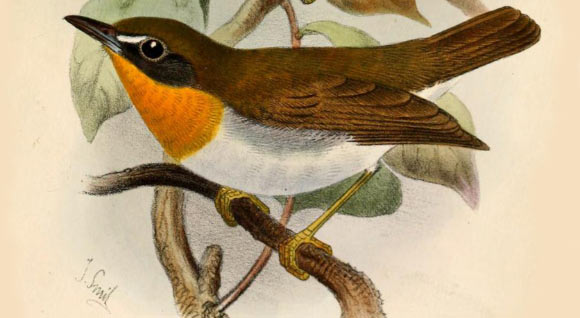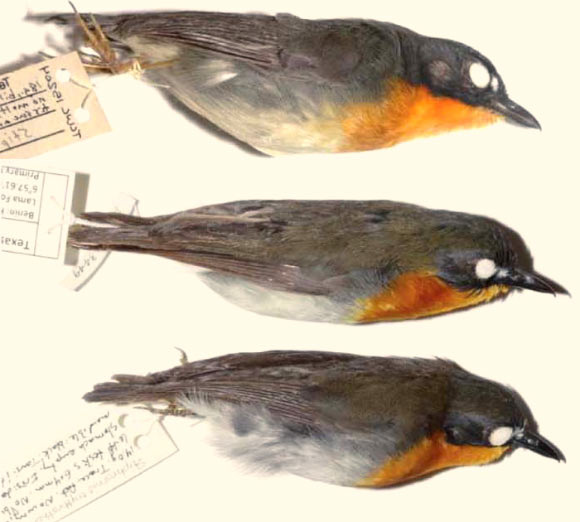Researchers have described three new species in the previously monotypic bird genus Stiphrornis: two from West Africa and one from the Congo.

Stiphrornis erythothorax, until now the only species in the genus Stiphrornis, by Joseph Smit, 1883, in the Catalogue of the birds in the British Museum, vol. 7.
The three new species are named the Ghana forest robin (Stiphrornis inexpectatus), the Dahomey forest robin (Stiphrornis dahomeyensis), and Rudder’s forest robin (Stiphrornis rudderi).
The paper describing these new species was published in the journal Systematics and Biodiversity on Sept. 28, 2016.
“Each of the three represents a distinct lineage based on our genetic analysis,” said lead author Prof. Gary Voelker, from Texas A&M University, College Station.
“The three are further distinguished from the forest robin (Stiphrornis erythrothorax) by clear differences in appearance such as wing and tail length and subtle differences in their plumage; one species has a distinctive song as well.”
Stiphrornis erythrothorax, until now the only species in this genus, was described by German ornithologist Gustav Hartlaub in 1855.
“The discovery of these three new species is a good example of the amount of potentially hidden diversity living in Afrotropical forests,” Prof. Voelker said.
“Our evidence runs directly counter to the belief of earlier research that said Afrotropical forests are static places where little evolutionary diversification has occurred.”
“The areas were referred to as ‘museums’ of diversity, meaning they believed because many of the birds look similar across their ranges, then they probably were the same species. That’s a point we are finding not to be true.”
“The point of most interest is that two of the three birds, which all look pretty much alike at first glance, live in close proximity to one another in an area that lacks significant geographic barriers typically associated with the forming of new species.”
“Despite this, the birds don’t share genetic makeup and their appearance is indeed somewhat distinct when closely analyzed.”

Three new Stiphrornis species, from top to bottom: S. rudderi, S. dahomeyensis, and S. inexpectatus. Image credit: Gary Voelker et al.
Stiphrornis inexpectatus is currently known from three locations in Ghana, one about 19 miles (30 km) south of Assin Foso, Central Region, one in Kakum National Park, Central Region, and another 16 miles (26 km) south-west of Goaso, Brong-Ahafo Region.
This species is named both for the unexpected nature of its distribution, being restricted to two provinces in Ghana, and the fact that there are no obvious geographic barriers that separate it from two other members of the genus.
The known distributional range of the second new species, Stiphrornis dahomeyensis, is currently limited to one locality in Benin, the Lama Forest and a second locality from 19 miles (30 km) south of Assin Foso, Central Region, Ghana.
The species is named after the Dahomey Gap, which separates the otherwise broadly distributed western and eastern expanses of Guineo-Congolian tropical forests, and in which the isolated Lama Forest is located. The Gap derives its name from the African kingdom of Dahomey, which lasted about 300 years and was located in the area of what is now Benin.
The third new species, Stiphrornis rudderi, is named in honor of James Earl Rudder, who led the 2nd Ranger Battalion during the invasion of Normandy, and was later President of Texas A&M University.
The known distributional range of Stiphrornis rudderi is currently limited to two localities near the city of Kisangani, Democratic Republic of the Congo.
The first is Yoko Forest Reserve, Ubundu District, on the south side of the Congo River. The second locality is Turumbu, about 5 miles (8 km) north of Yelenge, Yawenda District, on the north side of the Congo River.
_____
Gary Voelker et al. Three new species of Stiphrornis (Aves: Muscicapidae) from the Afro-tropics, with a molecular phylogenetic assessment of the genus. Systematics and Biodiversity, published online September 28, 2016; doi: 10.1080/14772000.2016.1226978







